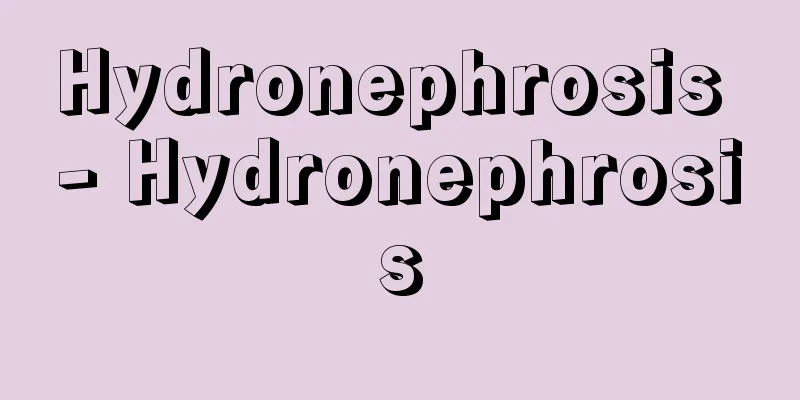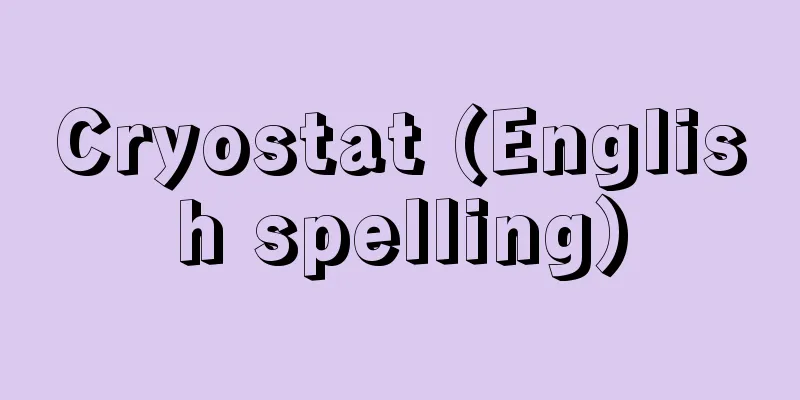Hydronephrosis - Hydronephrosis

|
◎ Urine accumulates in the renal pelvis or calyx [What kind of disease is it?] If there is a place in the urinary tract where urine flow is poor, urine produced in the kidneys will accumulate, causing internal pressure to rise, and the renal pelvis and calyces will fill with urine and expand. The kidney tissue (renal parenchyma) is compressed by the capsule from the inside, impeding blood flow. If this continues, the renal parenchyma will atrophy. This condition, in which the renal pelvis and calyces expand due to urinary pressure and the renal parenchyma shrinks, is called hydronephrosis. As the renal parenchyma becomes thinner, kidney function declines, but if urine flow is improved quickly, kidney function will almost return to normal. As hydronephrosis progresses, the entire kidney becomes like a swollen bag (capsular). If this occurs in both kidneys, it leads to chronic renal failure ("chronic renal failure") and progresses to uremia ("uremia"). If the blockage is located closer to the kidney than the bladder (upper urinary tract), hydronephrosis will occur in one kidney. If the blockage is located closer to the urethra than the bladder (lower urinary tract), hydronephrosis will occur in both kidneys. [Cause] Any condition that causes obstruction of the urinary tract can lead to hydronephrosis. Hydronephrosis can be broadly divided into two types: congenital (present at birth) and acquired. Most cases of hydronephrosis in children are caused by congenital diseases, while in middle-aged and older adults, it is more likely to be caused by acquired diseases. The main diseases that cause congenital narrowing of the urinary tract include stenosis found at the junction between the renal pelvis and ureter and the junction between the ureter and bladder, ureterocele ("ureterocele"), ectopic ureteral opening (abnormal ureteral opening)), urethral valve, urethral stenosis ("urethral stenosis"), and severe true phimosis ("phimosis"). In addition, vesicoureteral reflux ("vesicoureteral reflux"), neurogenic bladder ("neurogenic bladder") caused by spina bifida ("spina bifida"), meningocele, etc. can also cause urinary retention. For information on these underlying diseases, please see the respective sections. Acquired causes include primary obstruction directly within the urinary tract, and secondary obstruction caused by disease of the surrounding organs that extends to or puts pressure on the urinary tract. Primary causes include urinary tract stones such as kidney stones and ureteral stones ("urinary tract stones"), urinary tract cancers such as renal pelvis cancer, ureteral cancer ("renal pelvis cancer/ureteral cancer") and bladder cancer ("bladder cancer"), prostatic hyperplasia ("benign prostatic hyperplasia") and prostate cancer ("prostate cancer"), and narrowing of the urinary tract due to infection or injury. The main secondary causes are metastasis to the urinary tract from colon cancer (Column "Colon Cancer"), rectal cancer (Column "Rectal Cancer"), and uterine cancer (Column "Uterine Cancer"), and neurogenic bladder caused by disorders of the urinary nerves. [Symptoms] When urine suddenly stops flowing and the pressure inside the renal pelvis and calyces rises suddenly, stretching the capsule covering the surface of the kidney, causing a constant, severe pain from the back to the side where the kidneys are located. If the urinary tract obstruction is incomplete and the kidneys gradually expand, you may experience a mild dull pain in the lower back or no symptoms at all. As the kidneys enlarge, they put pressure on the surrounding stomach and intestines, which can cause digestive symptoms such as nausea and vomiting. In children, the abdomen may swell and be discovered incidentally as an abdominal mass. [Testing and diagnosis] The presence or absence of hydronephrosis can be easily detected with an abdominal ultrasound. Once hydronephrosis has been confirmed, the next step is to determine its extent and the location of obstruction in the urinary tract. The severity of hydronephrosis is determined by examining kidney function through urine and blood tests, and by examining the degree of renal pelvic dilation and the thickness of the renal parenchyma through imaging tests such as intravenous pyelography, CT scan, and renal scintigraphy. In addition, the site of obstruction is diagnosed by urinary tract imaging (kidneys, ureters, bladder, and urethra). ◎ Treatment depends on the cause and severity. [Treatment] Treatment varies depending on the cause and severity of hydronephrosis. When there is a certain amount of thickness of the renal parenchyma and it is expected that renal function will be restored if the obstruction is removed, the kidney is not removed and as much of it as possible is preserved. In such cases, if the underlying disease is treated and the urine that had accumulated in the renal pelvis and calyx begins to flow without resistance, the internal pressure of the renal pelvis decreases and function is restored. Sometimes, a tube (catheter) is inserted directly into the temporarily enlarged renal pelvis to drain urine and restore kidney function, after which the underlying disease can be treated or operated on. When renal function is unlikely to recover even if the kidney is left in place, the affected kidney may be removed after making sure that the other kidney is functioning adequately. [Precautions in daily life] Even if you are able to avoid having your kidney removed, you will need to be monitored regularly, so be sure to visit your hospital as instructed. Source: Shogakukan Home Medical Library Information |
|
◎腎盂(じんう)や腎杯(じんぱい)に尿がたまる [どんな病気か] 尿路のどこかに流れの悪い場所があると、腎臓(じんぞう)でできた尿がたまり、内部の圧力が上昇して、腎盂、腎杯が尿でいっぱいになって拡張してきます。 腎臓の組織(腎実質(じんじっしつ))は、内側から被膜(ひまく)に押しつけられるように圧迫され、血流が障害されますが、これが続くと、腎実質が萎縮(いしゅく)してきます。 このように、尿の圧力で腎盂腎杯が拡張し、腎実質の萎縮がおこっている状態を水腎症といいます。 腎実質が薄くなるので、腎臓の機能は低下していきますが、早めに尿の流れがよくなれば、機能はほとんどもとどおりに回復します。 水腎症がさらに進行すると、腎臓全体がふくらんだ袋のよう(嚢状(のうじょう))になります。 そして、これが両方の腎臓におこれば、慢性腎不全(まんせいじんふぜん)(「慢性腎不全」)となり、尿毒症(にょうどくしょう)(「尿毒症」)に移行します。 尿の流れをふさいでいる部位が、膀胱(ぼうこう)より腎臓に近いほう(上部尿路(じょうぶにょうろ))にあれば、片側の腎臓に水腎症がおこり、膀胱より尿道に近いほう(下部尿路(かぶにょうろ))にあれば、両側の腎臓に水腎症がおこります。 [原因] 尿路の通過障害をおこす病気は、なんでも水腎症の原因となります。 水腎症は、大きく先天性(生まれつき)と後天性の2つに分けることができます。 子どもの水腎症は、先天性の病気でおこるものが大部分で、中年以降のおとなでは、後天性の病気でおこるものが多くなります。 生まれつき尿路の狭窄(きょうさく)をおこす病気のおもなものは、腎盂と尿管の移行部および尿管と膀胱の移行部にみられる狭窄、尿管瘤(にょうかんりゅう)(「尿管瘤」)、尿管異所開口(にょうかんいしょかいこう)(尿管開口異常(にょうかんかいこういじょう)(「尿管開口異常」))、尿道弁(にょうどうべん)、尿道狭窄(にょうどうきょうさく)(「尿道狭窄」)、強度の真性包茎(しんせいほうけい)(「包茎」)などがあります。 また、膀胱尿管逆流(ぼうこうにょうかんぎゃくりゅう)(「膀胱尿管逆流」)や、二分脊椎(にぶんせきつい)(脊椎披裂(せきついひれつ)(「脊椎披裂(二分脊椎)」))、髄膜瘤(ずいまくりゅう)などによる神経因性膀胱(しんけいいんせいぼうこう)(「神経因性膀胱」)も、尿の停滞をおこします。 これら原因となる病気については、それぞれの項目を参照してください。 後天的な原因としては、直接尿路内に閉塞(へいそく)をおこすもの(原発性)と、周囲の臓器の病気が尿路におよんだり、圧迫したりして、閉塞(へいそく)をおこすもの(二次性)があります。 原発性のものとしては、腎結石(じんけっせき)や尿管結石(にょうかんけっせき)などの尿路結石(にょうろけっせき)(「尿路結石」)、腎盂がん、尿管がん(「腎盂がん/尿管がん」)、膀胱がん(「膀胱がん」)などの尿路のがん、前立腺肥大症(ぜんりつせんひだいしょう)(「前立腺肥大症」)と前立腺がん(「前立腺がん」)、感染や損傷によっておこる尿路の狭窄などがあります。 二次性のものとしては、大腸がん(コラム「大腸がん」)、直腸がん(「直腸がん」)、子宮がん(「子宮がん」)などの尿路への転移、排尿神経の障害による神経因性膀胱がおもなものです。 [症状] 尿が突然に流れなくなり、腎盂腎杯内の圧力が急に上昇して、腎臓の表面をおおっている被膜(ひまく)が引き伸ばされると、腎臓のある背中からわき腹にかけて、持続する強い痛みを感じます。 尿路の閉塞が不完全で、徐々に腎臓の拡張がおこる場合は、腰部に軽い鈍痛がみられたり、無症状のこともあります。 腎臓が大きくなると、まわりの胃や腸を圧迫するため、気持ちが悪くなったり(悪心(おしん))、嘔吐(おうと)など、消化器症状がみられることもあります。 子どもでは、腹部がふくらんで、偶然に腹部の腫(は)れとして発見されることもあります。 [検査と診断] 水腎症の有無は、腹部の超音波検査で簡単に調べることができます。 水腎症であることが確認されたら、つぎに、その程度や尿路の閉塞部位を調べます。 水腎症の程度は、尿・血液検査によって腎臓の機能を調べたり、静脈性腎盂撮影(じょうみゃくせいじんうさつえい)、CTスキャン、腎シンチグラフィなどの画像検査によって、腎盂の拡張の程度、腎実質の厚さを調べるなどして、判断します。 また、尿路造影(腎尿管、膀胱、尿道)により、閉塞部位を診断します。 ◎治療法は原因と程度による [治療] 水腎症の原因と程度によって治療法がちがってきます。 腎実質の厚さがある程度あって、閉塞をとりされば、腎臓の機能が回復されると期待できるときは、腎臓を摘出せず、できるかぎり残すようにします。 こういう場合、原因となった病気を治療し、腎盂・腎杯にたまっていた尿が抵抗なく流れるようになると、腎盂の内圧が下がって、機能は回復します。 ときには、一時的に拡張した腎盂に管(カテーテル)を直接入れて尿を排出し、腎臓の機能を回復させてから、原因となっている病気を治療・手術することもあります。 腎臓を残しても腎臓の機能の回復が望めないときは、反対側の腎臓の機能が十分にあるのを確認してから、水腎症になったほうの腎臓を摘出することもあります。 [日常生活の注意] 腎臓を摘出せずにすんだ場合でも、定期的な観察が必要なので、指示された通院をするようにしてください。 出典 小学館家庭医学館について 情報 |
Recommend
Manschette
...the former is an application of an electrical ...
King of Kado
Year of death: Keiun 2.12.20 (706.1.9) Year of bir...
Oval coin - Koban
〘Noun〙① A gold coin issued during the Edo period w...
Image processing
Machine processing of visual information such as ...
Japan Bowling Congress
...The Leisure White Paper (1993) by the Leisure ...
Price parity method
...If this index rises by 10%, the price of wheat...
Asbjornsen, PC (English name)
…After nearly a century of rampant educationalism...
Batista (English spelling) Fulgencio Batista y Zaldívar
1901〜73 President of Cuba (in office 1940-44, 1952...
Racemic modification - Rasemi (English spelling)
An optically inactive substance consisting of equ...
Uba-do
...In mountain sacred sites where women are not a...
Ausihi - Ausihi
…An industrial city developed at the confluence o...
Inpa (China) - Inha
…Teacher of Qiu Ying and Tang Yin. These three st...
Filial piety star
Please see the "Parent Star" page. Sour...
Kanzashi bracken - Kanzashi bracken
...More research is needed to see whether the one...
Compress - Anpo
A therapy that aims to improve illness or relieve...



![Kaminoyama [city] - Kaminoyama](/upload/images/67cb3f6d39ca6.webp)





